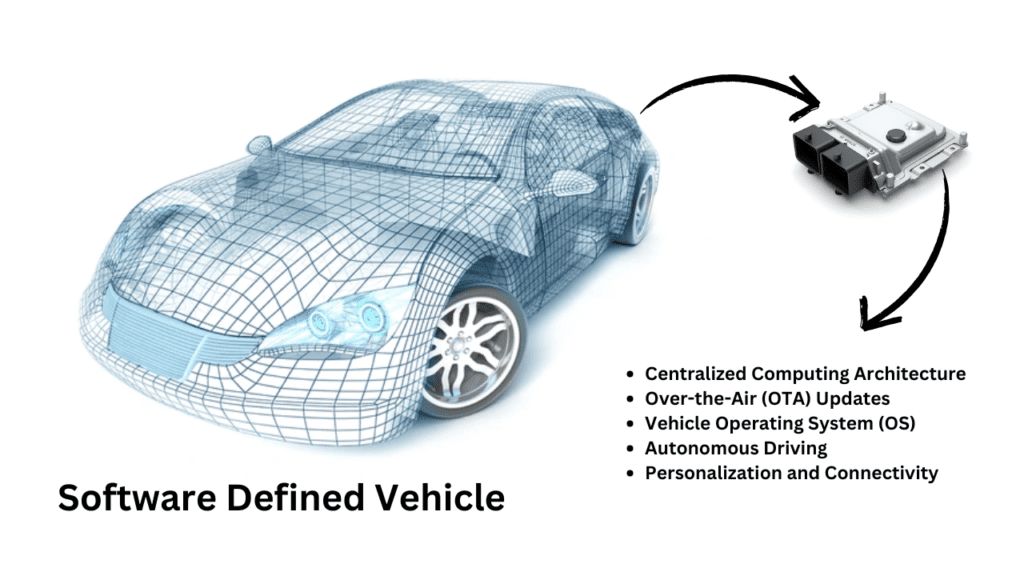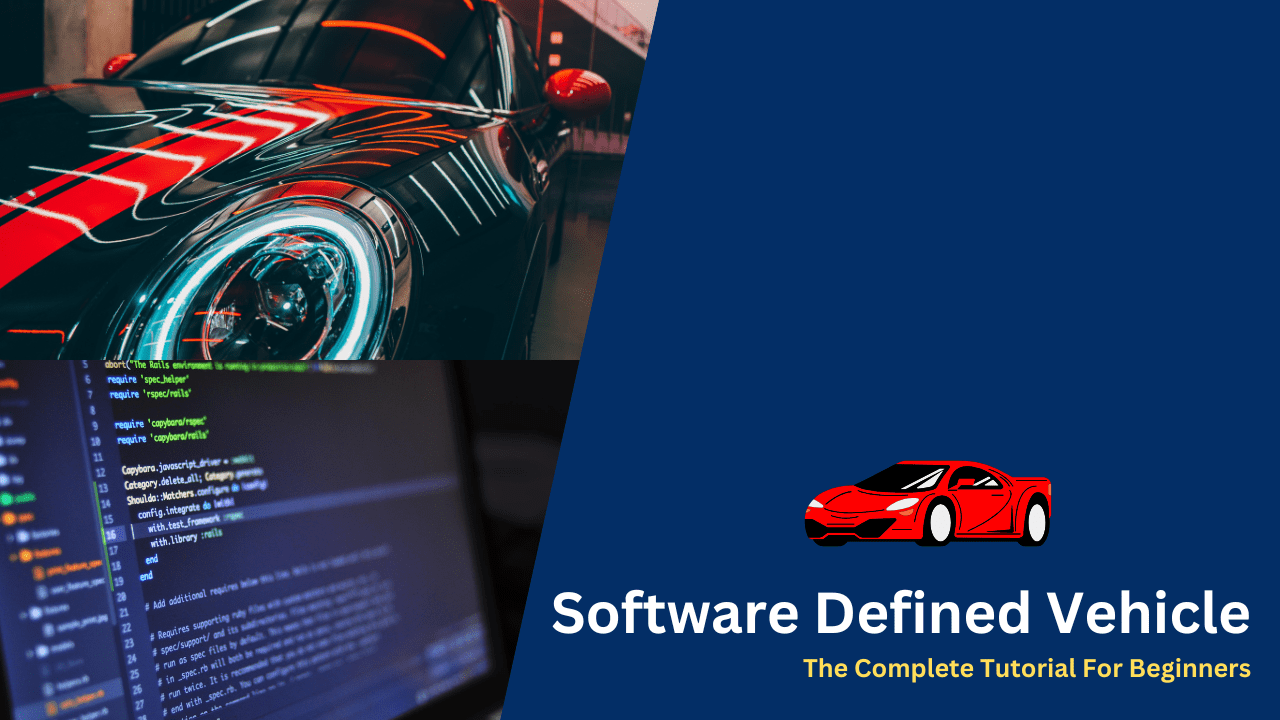Software Defined Vehicle: The Complete Tutorial For Beginners
Hello guys, welcome back to our blog. Here in this article, we will discuss Software Defined Vehicle, and how this technology will reshape the Automotive Industry and its key components.
Ask questions if you have any electrical, electronics, or computer science doubts. You can also catch me on Instagram – CS Electrical & Electronics.
- Journey of Semiconductor Chips from Manufacturing into Embedded Systems
- What Is Over The Air Updates, Features, Types
- Top Free Automotive Courses By Vector
Software Defined Vehicle
The Software Defined Vehicle (SDV) represents a revolutionary shift in the automotive industry, where software takes precedence over traditional hardware-based systems to control and enhance vehicle functionality. In contrast to conventional vehicles that rely on distributed Electronic Control Units (ECUs) for specific tasks, SDVs employ a centralized computing architecture to manage various functions such as engine control, braking, infotainment, and even autonomous driving. This centralization of control enables greater efficiency, better integration between systems, and more advanced features, all driven by software advancements.
Receiving Over-the-Air (OTA) updates is one of the main advantages of SDVs; this enables manufacturers to add new features, improve vehicle performance, and address possible problems without the need for physical interaction. This feature will provide the automobile sector with more flexibility and agility, much like how updates are made for smartphones. Additionally, because SDV software is modular, it can be customized and integrated with third-party apps, creating new opportunities for individualized driving experiences as well as seamless connection with cloud services and other networked devices.
The shift to SDVs is also in line with the rising desire for linked car ecosystems and driverless driving. SDVs may process real-time data from many sensors using artificial intelligence (AI) and machine learning (ML) as software advances, providing self-driving capabilities and improving safety. But there are drawbacks to this shift as well, like managing hardware-software integration, maintaining cybersecurity, and adhering to legal regulations. Despite these obstacles, SDVs are viewed as a vital part of automotive innovation going forward, providing ongoing advancements over the course of a vehicle’s lifetime.
Key Characteristics of SDVs:

01. Centralized Computing Architecture
Traditionally, a multitude of Electronic Control Units (ECUs) have been utilized in automobiles; each ECU is accountable for a distinct function, such as entertainment, brakes, or engine control. On the other hand, SDVs combine these tasks into fewer, more effective, centralized computing systems. By integrating several systems and enabling more intricate coordination between the vehicle’s subsystems, this centralized architecture lowers hardware complexity and boosts efficiency.
This change also helps to meet the increasing processing needs of cutting-edge technologies such as real-time car diagnostics, AI-powered decision-making, and autonomous driving. SDVs can manage the large data streams produced by sensors, cameras, and radars—all essential for complicated functions—better when they use high-performance processors.
02. Over-the-Air (OTA) Updates
The ability to get Over-the-Air (OTA) updates—which enable software to be updated remotely without requiring a visit to a service center—is one of the most revolutionary aspects of SDVs. With this capability, automakers can swiftly and effectively offer new features, correct bugs, or patch security vulnerabilities—just like they can with smartphones.
Both non-critical areas like infotainment and crucial systems like safety and braking can benefit from OTA upgrades. This lowers maintenance and recall costs, enhances customer satisfaction, and ensures that cars are kept up to date with the newest technology throughout their lives. Additionally, it gives automakers the ability to keep improving the usefulness and performance of their vehicles even after they have been sold.
03. Service-Oriented Architecture (SOA)
Software is modularised into services that may be independently developed, updated, and replaced in SDVs using a Service-Oriented Architecture (SOA). The dynamic aspect of the SDV is largely due to its flexibility, which makes it possible to integrate new features quickly and easily without having to completely redesign the system. SOA ensures that different car systems, such as infotainment, features for autonomous driving, or technology for driver support, can be improved or updated independently of one another.
Manufacturers can offer new services and even permit outside developers to create customized applications for the car by separating the hardware and software. By streamlining the process of introducing new features and services, this method also promotes innovation by increasing vehicle adaptability to evolving technology.
04. Autonomous Driving and AI Integration
The development of autonomous driving technologies depends on SDVs. Autonomous navigation requires real-time data processing from a variety of sensors, such as LiDAR, radar, and cameras, which is made possible by the centralized architecture and robust software.
The SDV uses machine learning (ML) and artificial intelligence (AI) algorithms to interpret this data and make split-second judgments that enable autonomous driving features like adaptive cruise control, obstacle recognition, and lane keeping. SDVs will eventually be able to learn from user behavior and driving situations as AI systems advance, enhancing performance and enhancing safety.
05. Cybersecurity
SDVs are more susceptible to cyberattacks than conventional cars since they depend more on software and communication. The communication pathways between the car, the cloud, and external devices must be secured given the increase in connected cars and over-the-air (OTA) updates.
To guard against potential assaults that might risk data integrity or vehicle safety, SDVs need strong cybersecurity protections including encryption, secure boot procedures, and real-time threat detection systems. SDV cybersecurity is mostly dependent on safeguarding software upgrades, blocking illegal access to vital car systems, and thwarting malware and hacker attacks.
06. Vehicle Personalization and Connectivity
SDVs’ increased capacity for personalization is another important characteristic. User customization of the driving experience is possible when more functions of the car are managed by software. The infotainment system, climate controls, driver profiles, and vehicle settings can all be changed in this way. SDVs are also made to integrate with mobile devices, cloud services, and other digital ecosystems. This is because they are highly connected devices.
Vehicles to vehicles (V2V) and vehicles to infrastructure (V2I) may communicate with one another and with each other’s vehicles in real time, and real-time updates, remote monitoring, and predictive maintenance are all made possible by this connectivity. Future smart city and driverless vehicle technologies depend on this networked ecosystem.
07. Real-Time Data Processing
Processing large volumes of data in real-time is a crucial component of SDVs. Modern cars are outfitted with sensors that gather information continuously on a variety of topics, including driver behavior, engine performance, and road conditions.
SDVs use AI algorithms and high-speed processors to analyze this data in real time, allowing for real-time modifications and decision-making to guarantee safety and optimal performance. Real-time data processing improves the vehicle’s ability to behave intelligently and autonomously, whether it is responding to a possible collision hazard, modifying vehicle dynamics, or adapting to changing weather conditions.
Why Are SDVs Important?
The need for more flexibility in vehicle design and functionality, as well as the growing need for connected vehicles and autonomous driving technology, are the main drivers of the shift toward SDVs. SDVs provide manufacturers with the opportunity to continuously upgrade vehicle features throughout the course of the product lifecycle, allowing them to adapt to shifting consumer demands and new market trends. Because software can be changed without changing hardware components, this method lowers overall manufacturing and maintenance costs and enables more affordable updates.
Additionally, SDVs facilitate the integration of cutting-edge technologies like machine learning (ML) and artificial intelligence (AI), which can boost energy efficiency, increase safety, and facilitate predictive maintenance. For example, AI-enabled systems in SDVs can track and evaluate driving habits, warn drivers of possible dangers, and maximize vehicle efficiency using data collected in real time.
Challenges in Implementing SDVs
Moving to Software Defined Vehicles (SDVs) has many benefits, but there are also several major obstacles that need to be overcome for the technology to be successfully deployed and used.
01. Cybersecurity
Cyberattacks are becoming more likely as cars become more software-driven and networked. Hackers might be able to gain access to vital systems like the brake, steering, and autonomous driving controls by taking advantage of software flaws. Additionally, the greater reliance on Over-the-Air (OTA) updates gives attackers new points of access. To defend SDVs from malicious assaults, it is imperative to build strong encryption and real-time threat detection measures, as well as to ensure the security of the software systems and communication channels.
02. Regulation and Compliance
SDVs are subject to strict safety, pollution, and data protection rules; however, the regulatory landscape for cars focused on software is still developing. The majority of current automotive standards are designed for hardware-based vehicles, and they fall short of explaining the intricacies of data security, OTA updates, and AI-driven autonomous systems.
Although governments and regulatory agencies are trying to modify rules, the adoption of SDVs may be slowed by the absence of worldwide regulations that are uniform and unambiguous. Automakers must balance advancing technical innovation with maintaining compliance with new norms.
03. Hardware-Software Integration
Especially in safety-critical areas like braking, steering, and autonomous driving tasks, ensuring smooth integration between hardware components (sensors, actuators, and control units) and the software systems that manage them is a significant problem.
The move to centralized computing calls for extremely complex software that can dependably interact with the hardware in real-time and under a variety of circumstances. Strict validation, testing, and fault-tolerance procedures are necessary to guarantee that hardware and software work together harmoniously without sacrificing vehicle performance or safety.
Conclusion
The automotive industry’s future is embodied in Software Defined Vehicles, which provide an ongoing foundation for innovation and advancement. SDVs give automakers the freedom to gradually improve car features, incorporate new technologies, and adapt to changing market needs by severing the software from the hardware. SDVs will be essential in driving vehicle automation, connection, and personalization as the automotive industry develops, radically altering the way we engage with and utilize automobiles.
This was about “Software Defined Vehicle: The Complete Tutorial For Beginners”. Thank you for reading.
Also, read:
- 100 + Electrical Engineering Projects For Students, Engineers
- 1000+ Electronics Projects For Engineers, Diploma, MTech Students
- 1000+ MATLAB Simulink Projects For MTech, Engineering Students
- 50 Advanced Level Interview Questions On CAPL Scripting
- 500+ Embedded System Projects For Engineer, Diploma, MTech, PhD
- 500+ Projects For Diploma Electrical, Electronics Student, Diploma Project
- 8051 Microcontroller Timers, TCON Register, TMOD Register
- A Complete Guide To FlexRay Automotive Protocol

